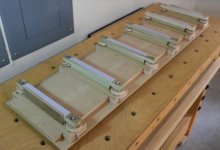So I just made a torsion box planer sled like the one pictured below. I shimmed my work surface (MFT/3) to make it flat. When I glued up the base on the MFT I checked the base for flat using a precision straight edge and it seemed flat. After letting the glue dry and rechecking everything it is definitely bowed (lower in the middle by ~1/16”). I realize this isn’t a huge amount but the purpose of the sled is getting a perfectly flat face on my lumber so I’m hoping to correct it without starting over.
Here’s my question: If I glue another layer of MDF to the base and make sure my surface is dead flat when I clamp it will it stay that way when I unclamp it or will it warp back to the original shape?
Any help is greatly appreciated. Thanks guys!
[attachimg=1]
Here’s my question: If I glue another layer of MDF to the base and make sure my surface is dead flat when I clamp it will it stay that way when I unclamp it or will it warp back to the original shape?
Any help is greatly appreciated. Thanks guys!
[attachimg=1]



